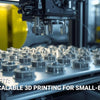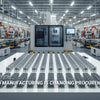FDM vs SLA: Which 3D Printing Technology Should You Actually Buy?

FDM vs SLA: Which 3D Printing Technology Should You Actually Buy?

Choosing the Right 3D Printer Can Save You Hundreds of Dollars and Countless Hours
Shopping for your first 3D printer feels overwhelming. Therefore, you'll find dozens of models promising amazing results, but the real question isn't which brand to buy. Instead, you need to decide between two fundamentally different technologies: FDM and SLA. This decision affects everything from your daily workflow to the types of projects you can actually complete.
Quick Answer: Which Technology Fits Your Needs?
| Factor | FDM (Fused Deposition Modeling) | SLA (Stereolithography) |
|---|---|---|
| Best For | Functional parts, beginners, larger objects, tougher materials | High-detail models, miniatures, smooth surfaces, jewelry patterns |
| Print Quality | Visible layer lines, 100-400 microns | Glass-smooth finish, 25-50 microns |
| Material Cost | $20-30 per kg | $50-80 per liter |
| Post-Processing | 15 minutes (support removal) | 30-60 minutes (washing + UV curing) |
| Durability | High impact resistance | More brittle (standard resins) |
| Learning Curve | Easier for beginners | Requires chemical handling |
Understanding These Two Technologies Changes Everything
Most people buy a 3D printer based on price alone. However, this approach often leads to disappointment when the printer can't handle their specific projects. Consequently, understanding how FDM and SLA work differently will help you make a smarter choice. Moreover, this knowledge prevents expensive mistakes that force you to buy a second printer later.
Table of Contents
- How Do FDM and SLA Actually Create Objects?
- What Kind of Surface Quality Can You Expect from Each Method?
- Which Materials Work Better for Your Application?
- What's the Real Time and Cost Investment for Each Technology?
- Conclusion
How Do FDM and SLA Actually Create Objects?
Walking up to an FDM printer, you'll immediately notice the spool of plastic filament. Meanwhile, an SLA printer hides its liquid resin inside a sealed vat. This visible difference hints at something deeper: these machines build objects in completely opposite ways.
The Core Process Breakdown
FDM Technology:
- Heats plastic filament to 180-250°C
- Pushes melted plastic through a tiny nozzle
- Draws each layer line by line, like a hot glue gun
- Waits for each layer to cool before adding the next
SLA Technology:
- Projects UV light patterns onto liquid resin
- Cures (hardens) entire layers at once
- Builds upside-down, pulling parts up from the resin vat
- Uses precise laser or LCD screen for extreme accuracy
Why This Difference Actually Matters for Your Projects
The mechanical process creates a ripple effect across everything else. For instance, FDM's line-by-line approach naturally creates visible ridges between layers. On the other hand, SLA's whole-layer curing produces almost invisible layer transitions. Additionally, FDM can use a wide variety of thermoplastics with different properties, while SLA limits you to photopolymer resins.
Think of it this way: FDM works like building a brick wall, where you can see each individual brick. In contrast, SLA resembles carving from a solid block, where the layers practically disappear. Furthermore, FDM gives you stronger parts that can handle rough use, whereas SLA delivers museum-quality details on delicate models.
This comprehensive 3D printing guide explains more about how layer-based manufacturing works and why it matters for your specific applications.
What Kind of Surface Quality Can You Expect from Each Method?
Picking up a freshly printed part reveals the most obvious difference between these technologies. Specifically, you can feel the texture difference with your eyes closed. This tactile distinction matters more than any specification sheet.
Surface Appearance Reality Check
FDM Surface Characteristics:
- Visible horizontal lines across the entire surface
- Slightly rough texture that catches your fingernail
- Layer height typically 0.1mm to 0.4mm (100-400 microns)
- Requires sanding or chemical smoothing for professional appearance
SLA Surface Characteristics:
- Nearly invisible layer lines on most surfaces
- Smooth, almost injection-molded appearance straight off the printer
- Layer height typically 0.025mm to 0.05mm (25-50 microns)
- Ready for painting or direct use without additional finishing
When comparing FDM SLA comparison accuracy, the numbers tell only part of the story. While SLA can achieve 25-micron layers, FDM typically bottoms out at 100 microns. However, this 4x difference translates into dramatically different visual results on curved surfaces.

When Does Surface Quality Really Matter?
Not every project demands glass-smooth perfection. For example, mechanical parts that get hidden inside assemblies don't need beautiful surfaces. Similarly, large architectural models often look better with some texture. Therefore, understanding when smoothness matters helps you choose between FDM and SLA.
Choose SLA for:
- Miniatures and tabletop gaming figures
- Jewelry master patterns for casting
- Dental models and aligners
- Display pieces and presentation models
- Any part where people will examine the surface closely
Choose FDM for:
- Functional brackets and mounting hardware
- Large props and cosplay armor
- Replacement parts for household items
- Prototypes where speed matters more than appearance
- Projects where you'll paint or coat the final piece anyway
Professional surface finish techniques can dramatically improve FDM results, but they add significant time and effort. In contrast, SLA parts often need minimal finishing work beyond support removal.
Which Materials Work Better for Your Application?
The plastic you choose determines whether your part survives real-world use or crumbles in your hands. Furthermore, each technology offers completely different material options with distinct strengths and weaknesses.
Material Property Comparison
FDM Filament Options:
- PLA: Easy printing, biodegradable, brittle in sunlight and heat
- ABS: Impact resistant, handles heat well, produces fumes during printing
- PETG: Chemical resistant, food-safe options available, good layer adhesion
- Nylon: Extremely tough, flexible, absorbs moisture from air
- TPU/TPE: Rubber-like flexibility, excellent for gaskets and protective cases
SLA Resin Options:
- Standard Resin: Brittle like hard plastic, excellent detail capture
- Tough Resin: ABS-like properties, still more brittle than FDM alternatives
- Flexible Resin: Shore hardness ranges, less stretchy than TPU
- Castable Resin: Burns out cleanly for jewelry casting
- Dental/Medical Resin: Biocompatible, certified for specific applications
Understanding the plastic 3D printing pros and cons helps narrow your technology choice based on your project requirements. Additionally, material costs vary dramatically between options.
Real-World Durability Differences
Lab tests only tell part of the story. In practical use, materials behave differently than their specification sheets suggest. For instance, standard SLA resin feels strong initially but becomes brittle over months, especially with UV exposure. Conversely, FDM parts maintain their properties longer but show visible layer lines forever.
FDM Advantages:
- Parts survive drops and impacts better
- Material properties stay consistent over years
- Can create living hinges and snap-fit connections
- Easier to glue, drill, and tap threads into prints
- Food-safe and outdoor-rated materials readily available
SLA Advantages:
- Isotropic strength (equally strong in all directions)
- No weak layer adhesion points
- Specialized materials for specific industries (dental, jewelry)
- Castable options for metal reproduction
- Water-resistant without additional sealing
When developing rapid prototypes, engineers often choose between functional prototypes vs detailed models based on testing needs. Mechanical testing requires FDM's tougher materials, while visual mockups benefit from SLA's superior appearance.
The selection of 3D printing plastics continues expanding, with new formulations addressing previous limitations in both technologies. However, FDM still maintains a significant advantage in material variety and mechanical properties.
What's the Real Time and Cost Investment for Each Technology?
The printer's price tag represents just the beginning of your actual expenses. Moreover, hidden costs and time requirements often surprise first-time buyers. Therefore, calculating the total investment prevents budget shock later.
Complete Workflow Breakdown
FDM Process Timeline:
- Design to print: 5 minutes (slice file, load filament, start print)
- Printing time: 4-12 hours depending on size and quality settings
- Cool down: 10-30 minutes for bed to cool and part to release
- Post-processing: 10-20 minutes (remove supports, light deburring)
- Total hands-on time: 20-30 minutes of active work
SLA Process Timeline:
- Design to print: 10 minutes (slice file, shake resin, start print)
- Printing time: 3-8 hours (often faster than FDM for small detailed parts)
- Washing: 10-20 minutes in isopropyl alcohol bath
- UV curing: 15-60 minutes under UV light
- Support removal: 10-30 minutes (more delicate than FDM)
- Total hands-on time: 45-90 minutes of active work
First-Year Cost Analysis
This desktop 3D printing guide breaks down realistic expenses based on moderate hobbyist use (printing 2-3 times per week):
FDM Annual Costs:
- Entry-level printer: $250-400
- Filament (12kg consumed): $240-360
- Replacement nozzles and parts: $30-50
- Electricity (~100 kWh): $15-20
- Year One Total: $535-830
SLA Annual Costs:
- Entry-level printer: $250-400
- Resin (8 liters consumed): $400-640
- Isopropyl alcohol (15 liters): $60-90
- Gloves, filters, paper towels: $50-75
- UV curing station: $80-150 (one-time)
- Replacement LCD screen: $50-80 (if needed)
- FEP film replacements: $30-50
- Year One Total: $920-1,485
Hidden Costs Nobody Mentions
Beyond the obvious expenses, both technologies carry additional considerations. For example, FDM printers need ventilation for ABS and other materials that produce fumes. Meanwhile, SLA requires proper resin disposal, which some municipalities regulate as hazardous waste. Additionally, your workspace needs protection from resin spills.
FDM Hidden Factors:
- Filament storage (moisture ruins some materials)
- Occasional bed adhesion solutions ($20-30)
- Potential enclosure for temperature-sensitive materials ($100-300)
- Learning curve wastes some material during failures
SLA Hidden Factors:
- Dedicated washing station or containers
- UV protection for resin storage area
- Resin disposal fees or approved disposal methods
- Higher failure costs (wasted resin more expensive than filament)
- Potential allergy development to uncured resin
When making your 3D printing technology selection, consider not just the upfront cost but your ongoing commitment. Furthermore, busy professionals often find FDM's simpler workflow worth slightly lower quality, while dedicated hobbyists embrace SLA's extra steps for superior results.
Conclusion
Choosing between FDM and SLA ultimately depends on your specific needs, budget, and willingness to manage different workflows. Both technologies deliver impressive results when matched to appropriate applications.
Choose FDM when you need:
- Durable functional parts that handle real-world stress
- Larger build volumes for bigger projects
- Lower ongoing material and maintenance costs
- Simpler workflow without chemical handling
- Wide material selection for different properties
- Better option for beginners and educational settings
Choose SLA when you need:
- Exceptional surface quality and fine detail capture
- Smooth finishes straight off the printer
- Professional appearance for presentation models
- Specialized applications like jewelry casting or dental work
- Smaller, intricate parts where detail matters most
- Isotropic strength properties
Many experienced makers eventually own both technologies because each excels at different tasks. However, if you can only start with one, this FDM vs SLA 3D printing guide should help you choose between FDM and SLA based on your primary use case. For most beginners, FDM offers a gentler learning curve and more forgiving workflow. Meanwhile, professionals working with detailed models or specialized applications often justify SLA's higher costs and complexity.
Remember that printer technology continues advancing rapidly. What seemed impossible five years ago now comes standard on entry-level machines. Therefore, whichever technology you choose today, you're entering an exciting field with endless creative possibilities.
Recommended Resources
[3D printing technology][^1]
[Plastic 3D printing pros and cons][^2]
---
[^1]: Explore this link to gain comprehensive insights into 3D printing technology, its applications, and advancements.
[^2]: This resource will provide a balanced view of plastic 3D printing, helping you make informed decisions.
[^3]: Explore this link to understand FDM technology, its advantages, and applications in 3D printing.
[^4]: Discover the details of SLA technology, its benefits, and how it differs from other 3D printing methods.
[^5]: Explore the advantages of Desktop 3D printing to understand how it can enhance your projects and creativity.





